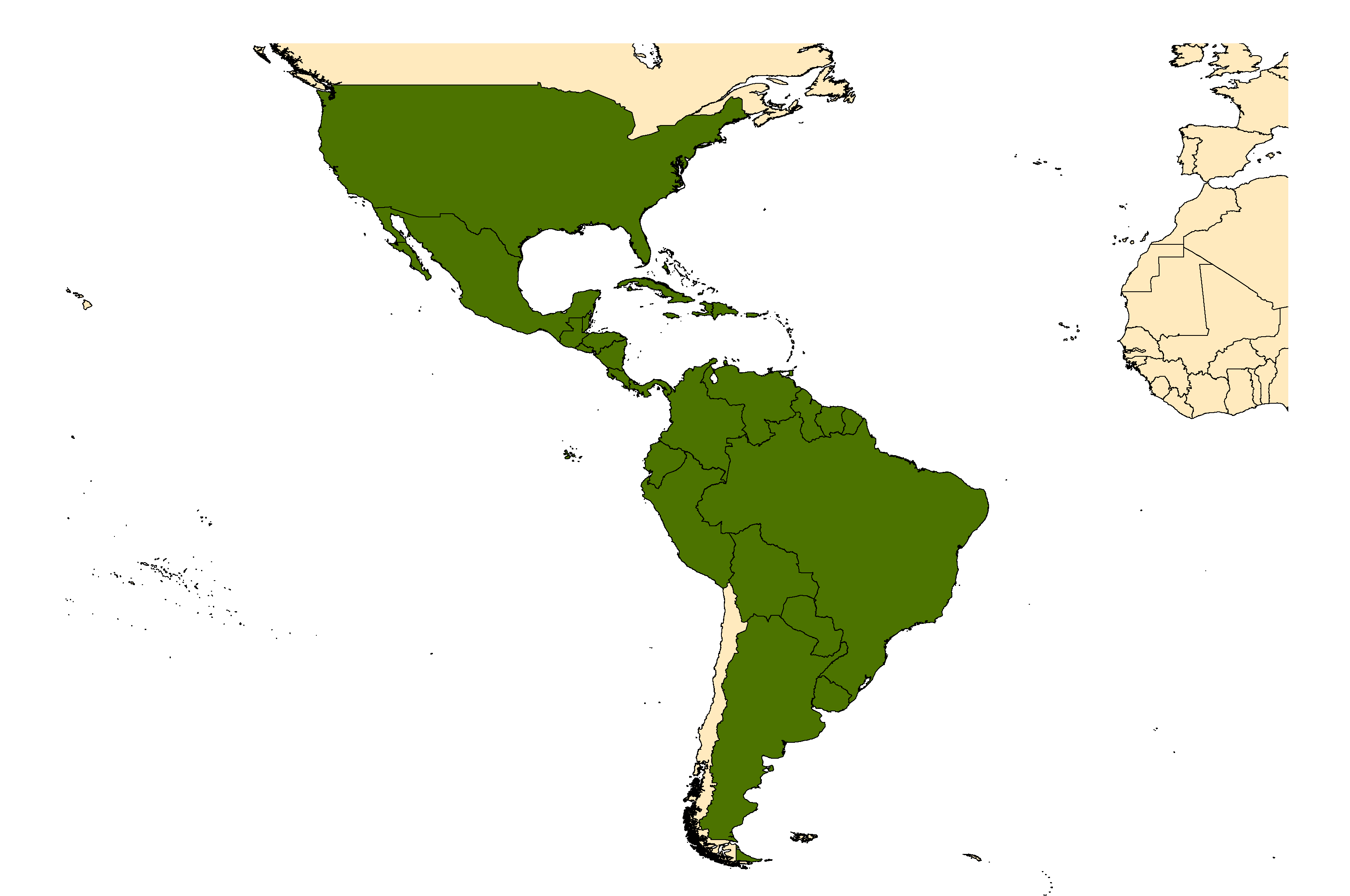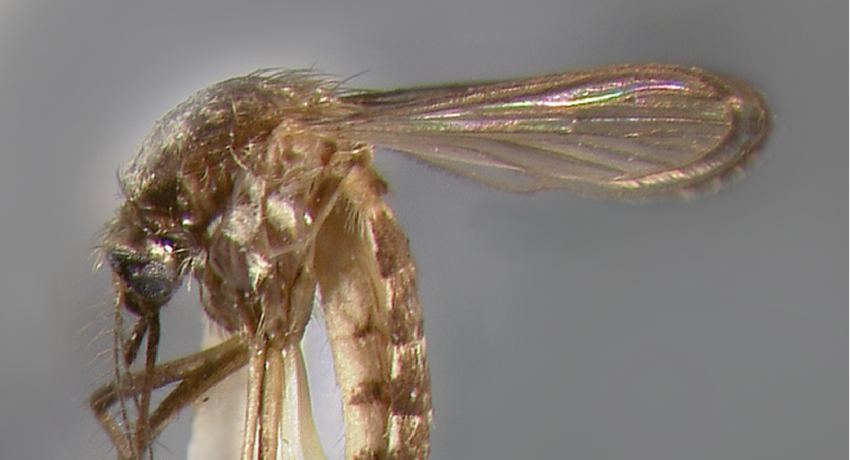NEOTROPICAL REGION
Etymology: not stated [shoulder, back (L); possibly refers to appearance of wearing a white scapular]
Aedes scapularis is the type-species of both the subgenus Ochlerotatus, and the Ochlerotatus Group, the largest informal group in the subgenus comprising 23 species. Aedes scapularis is closely related to the Grenadan endemic Ae. phaeonotus Arnell and Ae. comitatus Arnell, endemic to Colombia. Aedes scapularis is one of the most common and widely distributed mosquitoes in the New World.
Type locality: Vicinity of Belém, Para, Brazil
Type depository: Location Unknown (LU)
DIAGNOSTIC CHARACTERS (Click photos to view; mouse over and click large photo to zoom in.)
ADULT (illustrated): Thorax: Scutum with broad area of yellowish to white scales extending from anterior margin to a little beyond middle; scutal scales narrow and curved; lower mesepimeral setae absent. Leg: Ti-III anteriorly and Ta-III basally with white scales in long stripes.
LARVA (not illustrated): Head: Seta 5-C single. Thorax: Seta 3-P with ≥3 branches. Abdominal segments: Integumental spicules long and conspicuous; seta 1-III usually 3-branched. Terminal segments: Comb scales in 2–3 rows, evenly fringed; pecten spines evenly spaced ending just beyond middle of siphon.
TAXONOMIC KEYS
Darsie & Ward 2005
Becker et al. 2010
![]()
WRBU – Aedes – Neotropical Region – Larva
Exemplar DNA sequences
Ae. scapularis COI: KT766398–404, MF172265–67.
BIONOMICS
Immatures
Like other floodwater species, Ae. scapularis lays its dessication-tolerant eggs in grasses prone to flooding. Large volumes of eggs may be flooded at once to produce mosquito densities abundant enough to kill cattle. Although most common in temporary freshwater pools with soil bases, immatures have also been collected in the vegetated margins of large lakes, ponds, and swamps, as well as in rock holes and crabholes, and a variety of artificial containers. This ecological plasticity in immature habitats is unusual in a single species.
Adults
Aedes scapularis appears well-adapted to man-made environments, and can reach high densities in low-elevation urban environments, especially in urban parks. It will readily enter homes to feed. In Brazil, the species bites at dusk, but in Surinam and French Guyana, Ae. scapularis are reportedly diurnal with biting peaks between 12:00–15:00. DNA barcoding analysis have shown high genetic diversity within Ae. scapularis populations in Brazil, with genetically similar clusters correlated with diagnosable wing geometric patterns, suggestive of cryptic speciation.
DISTRIBUTION NOTES
Argentina, Bahamas, Belize, Bolivia, Brazil, Colombia, Costa Rica, Cuba, Dominican Republic, Ecuador, El Salvador, French Guiana, Grenada, Guatemala, Guyana, Haiti, Honduras, Jamaica, Mexico, Nicaragua, Panama, Paraguay, Peru, Puerto Rico, Suriname, Trinidad & Tobago, United States (continental), Uruguay, Venezuela.

WRBU VECTOR HAZARD REPORTS
VHR: Mosquitoes of the Caribbean
View other WRBU Vector Hazard Reports
Available GIS Models
Ae_scapularis_Dornak_1 South & Central America
IMPORTANT REFERENCES (full citations below)
Rondani 1848: 109 *F; as Culex)
Séguy 1924: 71 (M genitalia*)
Coher 1949 (1948): 101 (F*)
Breland 1951: 369 (L*)
Yamaguti & LaCasse 1951d: 170 (M*, F*, L*)
Lane 1953: 665 (M*, F, P*, L*)
Forattini 1965 (E*)
Belkin et al. 1971: 19 (type locality info.; type locality restricted to vicinity of Rio de Janeiro (Guanabara))
Arnell 1976: 57 (M*, F*, P*, L*; distribution; type locality corrected to vicinity of Belém, Para, Brazil)
Forattini 1996 (E*)
Reinert 2000e (F*)
Forattini 2002 (E*)
Reinert 2002e: Fig. 26 (F*)
Rossi & Marinez 2003: 472 (distribution; Uruguay)
Darsie & Ward 2005 (F*, L*; keys, distribution)
dos Santos-Mallet et al. 2010 (E*)
Becker et al. 2010: 383 (F*, L*; key, taxonomy, distribution, bionomics)
Berti et al. 2015 (distribution; Venezuela)
CURRENT SYNONYMS
syn. confirmatus Lynch Arribálzaga
1891: 146 (F; Ochlerotatus). Type locality: Navarro, Buenos Aires, Argentina (BA). References: Belkin et al. 1968: 14 (lectotype designation according to Casal).
syn. hemisurus Dyar & Knab
1906d: 199 (L). Type locality: Jamaica (NE). References: Stone & Knight 1956a: 218 (type info.); Belkin et al. 1970: 161 (M*, F, P*, L*; from synonymy with scapularis Rondani).
syn. indolescens Dyar & Knab
1907a: 11 (F). Type locality: Cayamas, Cuba (USNM). References: Stone & Knight 1956a: 219 (type info.); Belkin et al. 1970: 161 (change in synonymy); Arnell 1976: 58 (synonymy).
syn. camposanus Dyar
1918d: 128 (M, F). Type locality: Guayaquil, Ecuador (USNM). References: Leví-Castillo 1951b: 383 (M*; from syn. with euplocamus); Leví-Castillo 1952a: 262 (M*); Stone & Knight 1956a: 216 (type information, lectotype designation); Arnell 1976: 58 (synonymy).
CURRENT SUBSPECIES
None
CITED REFERENCES
Arnell, J. H. (1976). Mosquito studies (Diptera, Culicidae) XXXII. A revision of the scapularis group of Aedes (Ochlerotatus). Contributions of the American Entomological Institute, 13(3).
Becker, N., Petrić, D., Zgomba, M., Boase, C., Madon, M., Dahl, C., & Kaiser, A. (2010). Mosquitoes and their control (Second ed.). Berlin Heidelberg: Springer-Verlag.
Belkin, J.N., Heinemann, S.J., & Page, W.A. (1970). The Culicidae of Jamaica (Mosquito studies. XXI) Contributions of the American Entomological Institute, 6(1), 458.
Belkin, J.N., Schick, R.X., & Heinemann, S.J. (1968). Mosquito studies (Diptera, Culicidae). XI. Mosquitoes originally described from Argentina, Bolivia, Chile, Paraguay, Peru, and Uruguay. Contributions of the American Entomological Institute, 4(1), 9–29.
Belkin, J.N., Schick, R.X., & Heinemann, S.J. (1971). Mosquito studies (Diptera, Culicidae). XXV. Mosquitoes originally described from Brazil. Contributions of the American Entomological Institute, 7(5), 1–64.
Berti, J., Guzmán, H., Estrada, Y., & Ramírez, R. (2015). New records of mosquitoes (Diptera: Culicidae) from Bolívar State in South Eastern Venezuela, with 27 new species for the state and 5 of them new in the country. Frontiers in Public Health, 2, 10.
Breland, O.P. (1951). The immature stages of Aedes infirmatus Dyar and Knab with notes on related species (Diptera: Culicidae). Annals of the Entomological Society of America, 44, 362–371.
Coher, E.I. (1949). A study of the female genitalia of Culicidae; with particular reference to characters of generic value. Entomologica Americana, 28 (1948) (3), 75–112.
Darsie, R.F., Jr., & Ward, R.A. (2005). Identification and geographical distribution of the mosquitoes of North America, north of Mexico. Gainesville, FL: University Press of Florida.
dos Santos-Mallet, J.R., Müller, G.A., Gleiser, R.M., Alencar, J., Marques, W.A., Sarment, J.S. & Marcondes, C.B. (2010). Scanning electron microscopy of the eggs of Aedes scapularis from Southern South America. Journal of the American Mosquito Control Association, 26(2), 205–209.
Dyar, H.G. (1918d). New American mosquitoes (Diptera, Culicidae). Insecutor Inscitiae Menstruus, 6, 120–129.
Dyar, H.G., & Knab, F. (1906d). The larvae of Culicidae classified as independent organisms. Journal of the New York Entomological Society, 14, 169–230.
Dyar, H.G., & Knab, F. (1907a). Descriptions of some American mosquitoes. Journal of the New York Entomological Society, 15, 9–13.
Forattini, O.P. (1965). Entomología Médica. 3.0 Volume. Culicini: Haemagogus, Mansonia, Culiseta, Sabethini, Toxorhynchitini. Arboviruses. Filariose bancroftiana. São Paulo: Universidade de São Paulo.
Forattini, O.P. (1996). Culicidologia médica. Vol. I. Principios gerais, morfología, glossario taxonomico. São Paulo.
Forattini, O.P. (2002). Culicidologia Médica. Vol. II. Identificaçao, Biologia, Epidemiologia. São Paulo.
Lane, J. (1953). Neotropical Culicidae (Vols. I, II). São Paulo: University of São Paulo.
Leví-Castillo, R. (1951b). Nota taxonomica sôbre la espécie equatoriana Aedes (Ochlerotatus) camposanus Dyar 1918 (Dipt. Culicidae). Revista de Entomología, 22, 383–388.
Leví-Castillo, R. (1952a). Redescription of Aedes (Ochlerotatus) camposanus Dyar (1918) as a valid species found in the coastal plain of Ecuador. Pacific Science, 6, 262–264.
Lynch Arribalzaga, F. (1891). Dipterologia argentine. Revista del Museo de La Plata, 1, 345–377.
Reinert, J.F. (2000e). Comparative anatomy of the female genitalia of genera and subgenera in tribe Aedini (Diptera: Culicidae). Part V. Genus Aedes Meigen. Contributions of the American Entomological Institute, 32(3), 1–102.
Reinert, J.F. (2002e). Comparative anatomy of the female genitalia of genera and subgenera in tribe aedini (Diptera: Culicidae). Part XIII. Genus Ochlerotatus Lynch Arribalzaga. Contributions of the American Entomological Institute, 33(1), 1–111.
Rondani, C. (1848). Esme di varie specie d’Äôinsetti ditteri brasiliani. Studi entomologici (Turino), 1, 63–112.
Rossi, G.C., & Martinez, M. (2003). Mosquitoes (Diptera: Culicidae) from Uruguay. Entomon Vect, 10(4), 469–478.
Seguy, E. (1924). Les moustiques de l'Afrique Mineure, de l'Egype et de la Syrie. Encyclopedie Entomologique (A), 1, 1–257.
Stone, A., & Knight, K.L. (1956a). Type specimens of mosquitoes in the United States National Museum. II. The genus Aedes (Diptera, Culicidae). Journal of the Washington Academy of Sciences, 46(7), 213–228.
Yamaguti, S., & LaCasse, W.J. (1951d). Mosquito fauna of North America. Part V – Genus Aedes. Office of the Surgeon, Headquarters, 8th Army, APO 343. United States. Office of the Surgeon-General. 207th Malaria Survey Detachment.
CITE THIS PAGE
Walter Reed Biosystematics Unit (Year). Aedes scapularis species page. Walter Reed Biosystematics Unit Website, http://wrbu.si.edu/vectorspecies/mosquitoes/scapularis, accessed on [date (e.g. 03 February 2020) when you last viewed the site].









































































































































































